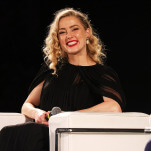A Chat With the Producer Calling Out Sexist Descriptions of Women in Scripts on Twitter
LatestFilmmaker Ross Putman struck a nerve Tuesday night when he started a Twitter account that only tweets the first descriptions of female characters in film scripts. Surprise surprise: they’re usually pretty sexist.
The account, @FemScriptIntros, has already amassed more than 10,000 followers due to the utter cringe-worthiness of the descriptors. The intros tend to rely on trite references to a woman’s beauty and vague adjectives that usually—what do you know—bring it back to her appearance.
Intrigued, I asked Putman about this project over email. As a producer and script reader, he estimates that in the last eight years, he’s read over 4,000 scripts.
He says that he used to complain about the horrible descriptions he’d encountered on Facebook in order to “remain sane.” Positive feedback from his friends—many of them also work in the film business—inspired him to start the Twitter account.
But the more that I read, the more I started to recognize some pretty awful constants. For every confused “you’re” and “your,” there’s just as much latent misogyny and sexism in the scripts I read. Women are first and foremost described as “beautiful,” “attractive,” or—my personal blow-my-brains-out-favorite, “stunning.” They’re always “stunning” in a certain dress or “stunning” despite being covered in dirt because they’re a paleontologist—or whatever. I found myself posting to Facebook far too often “here comes another script with our 45 year-old male lead dating a 25 year-old woman,” and decided I was going to keep track of the female character introductions in scripts I read for a few weeks.
I went back and combed through past scripts too, and the patterns were pretty disconcerting. I plan on posting every one that I read, and there are plenty that aren’t offensive, but honestly, most of them have some element—subtle or overt—that plays into latent objectification.
It’s obvious and unsurprising that a woman’s physical appearance is often considered a major character trait and a necessary piece of information for telling the story at hand.
-

-

-

-

-

-

-

-

-

-

-

-

-

-

-

-

-

-

-

-

-

-

-

-

-

-

-

-

-

-

-

-

-

-

-

-

-

-

-

-








































